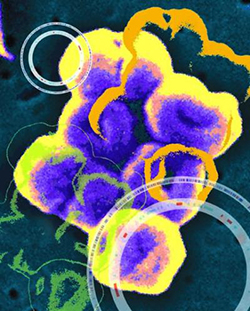 |
| Scanning electron image of the pathogen Acinobacter with maps of genome and alien sequence.--Courtesy of J.Carr/CDC; T.Gianoulis, D.Massa/Yale |
To combat a particularly resistant strain of bacteria plaguing military personnel in the Middle East, U.S. researchers have developed a nucleic-acid-mimicking conjugate that targets and silences genetic material within the bacteria rather than, like many antibacterial drugs, disrupting cell functions. And beyond this particular strain, the conjugate can potentially target almost any disease with a genetic component, according to study results.
The peptide-conjugated phosphorodiamidate morpholino oligomer, or PPMO, is essentially a synthetic form of microRNA, which has been used to silence strands of genetic code that cause diseases, though delivering the treatment to the genetic material in a cell has been tricky. This time, the target is the pathogen Acinetobacter, an infection-causing bacteria that has been a major problem overseas. The researchers from Oregon State University, University of Texas Southwestern Medical Center and Sarepta have shown that the peptide conjugate resulted in a reduction of infectious bacteria in mice by more than 90%, according to reports from both universities. MA-based pharma company Sarepta ($SRPT) supplied the PPMOs.
To accurately and effectively deliver the PPMOs to the bacterium's genetic code, the conjugate must be pathogen-specific, whereas broad-spectrum antibiotics are designed to kill multiple pathogens. But the PPMO technology can be used to target other bacteria and virus types, as well as parts of their genetic code involved in antibiotic resistance.
"We set out to target specific genes in Acinetobacter in an effort to inhibit the bacterium's growth," David Greenberg of UT said in a statement. "With infections from drug-resistant pathogens rising rapidly, there is an urgent need to come up with new approaches such as the use of PPMOs to spur antibiotic development."
Although scientists have not begun testing the conjugate in humans, one with a similar structure has been tested as a treatment for Duchenne muscular dystrophy, according to the UT report.
"The mechanism that PPMOs use to kill bacteria is revolutionary," lead author Bruce Geller of OSU said in a statement. "They can be synthesized to target almost any gene, and in that way avoid the development of antibiotic resistance and the negative impacts sometimes associated with broad-spectrum antibiotics."
- here's the OSU report
- and here's the UT Southwestern Medical Center release
Related Articles:
Team shoos away superbugs with puffs of powder
Antibiotic-delivery strategies could cut back on side effects
'Spider' protein can deliver stable vaccines in high concentration